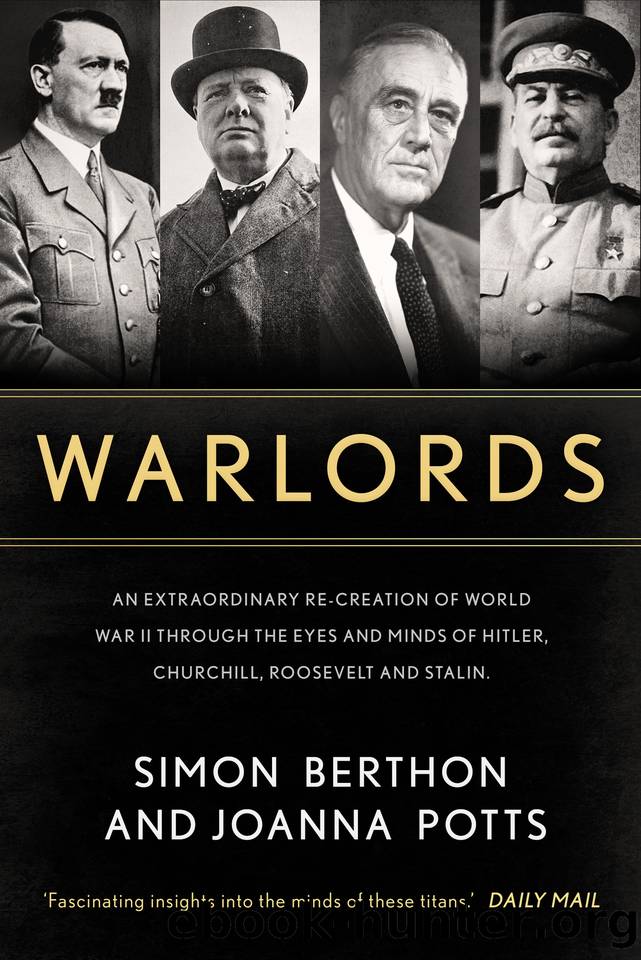Warlords: An extraordinary re-creation of World War II through the eyes and minds of Hitler, Churchill, Roosevelt and Stalin by Berthon Simon & Potts Joanna

Author:Berthon, Simon & Potts, Joanna [Berthon, Simon]
Language: eng
Format: epub
Publisher: Lume Books
Published: 2020-10-20T16:00:00+00:00
CHAPTER TEN
10 Aprilâ7 September 1943
On 13 April 1943 the Germans, in a flurry of anti-Soviet propaganda, announced their ghastly find at Katyn. While he launched his propaganda strike, Hitler was also planning his next assault on Soviet forces, Operation âCitadelâ, a massive attack on the Red Army centred around the Kursk salient. It was intended to put the setback of Stalingrad into the shade. âThis attack is of decisive importance,â Hitler announced in an order of 15 April, âit must be a quick and conclusive success. The victory of Kursk must shine like a beacon to the world.â [1]
The Katyn revelations were soon spreading their poison among Hitlerâs opponents. Moscow immediately denied any responsibility and pointed the finger at the Nazis. The London-based Polish government in exile, the government for which Britain had first gone to war in 1939, was sure that the Russians were guilty. After Operation âBarbarossaâ, the London Poles had swallowed their bitterness at the NaziâSoviet pact and signed a friendship treaty with the Soviet Union for the sake of Allied unity against Hitler. Since then, they had frequently asked the Russians, including Stalin himself, what had happened to the 20,000 Polish officers and political prisoners who had gone missing while the pact was in place. The answers were never satisfactory, Stalin airily suggesting that they would turn up in due course. Now they had â murdered.
At 1.30 p.m. on 15 April General Wladyslaw Sikorski, the Prime Minister of the Polish government in exile, and Count Edward Raczynski, the Polish ambassador in London, arrived at 10 Downing Street for lunch with Churchill and Sir Alexander Cadogan. Churchill understood their anger but warned them not to do or say anything that might provoke Stalin. He knew that the long-term future of Poland depended on building a relationship with its powerful Russian neighbour; the London Poles must steel themselves to get along with Stalin, however distasteful that might be. Even so, Churchill was under no illusions that the Soviets were almost certainly responsible for the murders. âAlas,â he admitted to Sikorski and Raczynski, âthe German revelations are probably true. The Bolsheviks can be very cruel.â [2]
The next day, acting counter to the advice Churchill had dispensed, Sikorski issued a public protest about the Katyn massacre and made it clear that the London Poles believed the Soviet government was to blame. He demanded an investigation by the International Red Cross.
Stalin, far from being embarrassed by the revelations, now smelled opportunity. Even though he had signed a friendship treaty with Sikorski, he thoroughly disliked his government, which was determined to restore Polandâs freedom and independence. Instead Stalin wanted any future Polish government to be subservient to Russia. Five days later, 21 April, he wrote identical angry letters to his allies, Churchill and Roosevelt: âThe anti-Soviet slander campaign, launched by the German fascists in connection with the Polish officers whom they themselves murdered in the Smolensk area, in German-occupied territory, was immediately seized upon by the Sikorski government and is being fanned in every way by the Polish official press.
Download
This site does not store any files on its server. We only index and link to content provided by other sites. Please contact the content providers to delete copyright contents if any and email us, we'll remove relevant links or contents immediately.
The Vikings: Conquering England, France, and Ireland by Wernick Robert(79176)
Ali Pasha, Lion of Ioannina by Eugenia Russell & Eugenia Russell(39928)
The Vikings: Discoverers of a New World by Wernick Robert(36828)
The Conquerors (The Winning of America Series Book 3) by Eckert Allan W(36705)
Cecilia; Or, Memoirs of an Heiress — Volume 1 by Fanny Burney(32075)
Cecilia; Or, Memoirs of an Heiress — Volume 3 by Fanny Burney(31469)
Cecilia; Or, Memoirs of an Heiress — Volume 2 by Fanny Burney(31419)
Empire of the Sikhs by Patwant Singh(22775)
Hans Sturm: A Soldier's Odyssey on the Eastern Front by Gordon Williamson(18332)
The Secret History by Donna Tartt(18213)
Cat's cradle by Kurt Vonnegut(14777)
Sapiens: A Brief History of Humankind by Yuval Noah Harari(13995)
Pimp by Iceberg Slim(13798)
Talking to Strangers by Malcolm Gladwell(12888)
Norse Mythology by Gaiman Neil(12861)
Leonardo da Vinci by Walter Isaacson(12812)
Underground: A Human History of the Worlds Beneath Our Feet by Will Hunt(11846)
4 3 2 1: A Novel by Paul Auster(11812)
The Radium Girls by Kate Moore(11634)
